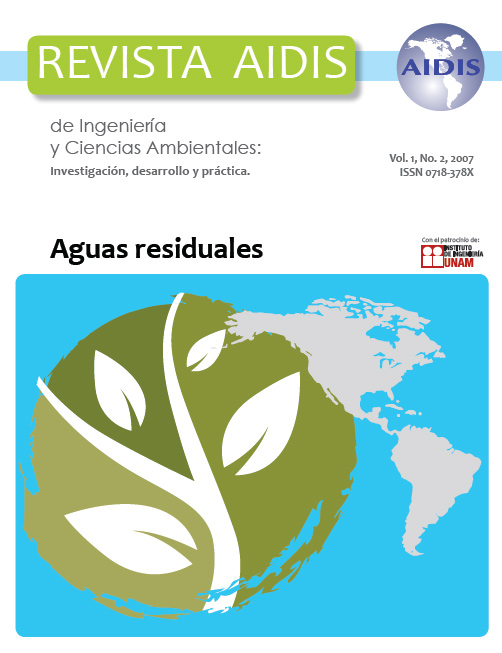Pós-tratamento de efluente de tanque séptico por biofiltro aerado submerso
Contenido principal del artículo
Resumen
Anaerobic reactors are sanitary sewage treatment units widely used in Brazil due to their low construction and operation costs, operational simplicity and low sludge production. However, these units do not provide the best effluent discharge conditions and most of the time these discharges do not comply with the Brazilian environmental legislation (CONAMA Resolution 357/05). This work studied a bench‐scale Biological Aerated Filter (BAF) with useful volume of 6.3 liters, being operated as post‐treatment of a 27 liter Septic Tank (ST) that treated synthetic sewage simulating domestic/sanitary sewage. The BAF was operated as the Septic Tank post‐treatment unit in two phases during a 120 day‐period. In the first phase the BAF received an average volumetric organic loading (VOL) of 1.05 kg COD/m3∙day, for a surface loading rate (SLR) of 5.01 m3/m2∙day, corresponding to a 4 hour hydraulic retention time (HRT). In the second phase the BAF received an average VOL of 1.97 kg COD/m3∙day, for a SLR of 10.02 m3/m2∙day, corresponding to a 2 hour HRT. During the monitoring phase, the removals of residual organic matter and solids present in the effluent of the Septic Tank unit were evaluated. In the first phase the BAF generated an effluent with average concentrations of COD, TOC and BOD of 46 ± 19 mg∙l‐1, 13 ± 3 mg∙l‐1 and 20 ± 9 mg∙l‐1 and efficiencies of 80%, 87% and 78%, respectively. In the second phase these concentrations were 53 ± 10 mg∙l‐1, 21 ± 5 mg∙l‐1 and 21 ± 5 mg∙l‐1 and efficiencies of 79%, 84% and 79%, respectively. As for SS and VSS, the reactor showed efficiencies of 62% and 68%, with an average concentration in the final effluent of 16.9 mg∙l‐1 and 11.3 mg∙l‐1 in the first phase. In the second phase the removal efficiencies of SS and VSS were 37% and 50%, with average concentrations in the final effluent of 18 mg∙l‐1 and 9 mg∙l‐1. Therefore, it is possible to affirm that the BAS unit, under the typical conditions of this study, can promote a suitable removal of the residual organic matter and of SS, thus assuring that the discharge of the sanitary effluent complies with the Brazilian environmental legislation.
Detalles del artículo
Cómo citar
[1]
Alves Barbosa, S. y Antunes Nolasco, M. 2009. Pós-tratamento de efluente de tanque séptico por biofiltro aerado submerso. Revista AIDIS de ingeniería y ciencias ambientales: Investigación, desarrollo y práctica. 1, 2 (nov. 2009).
